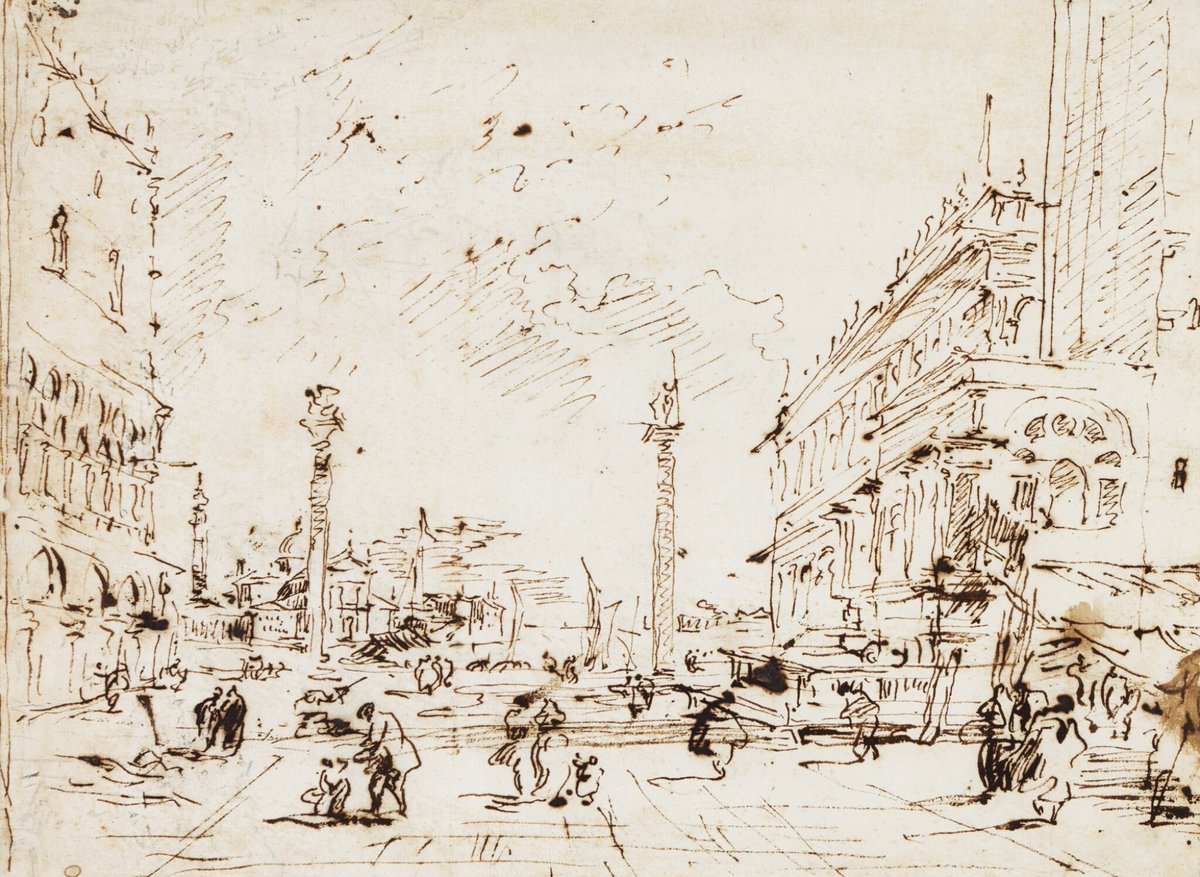Francesco Guardi - View of the Piazzetta, Venice, looking towards S. Giorgio Maggiore
Francesco Guardi
1712 - 1793
Recto: View of the Piazzetta, Venice, looking towards S. Giorgio Maggiore
Verso: Study for a Madonna and Child and an adoring Saint, by Giovanni Battista Tiepolo (Venice 1696-1770 Madrid)
Pen and brown ink over traces of black chalk (recto);
pen and brown ink (verso)
243 by 330 mm; 9½ by 13 in.
Marie-Pierre-Louis Hélie de Talleyrand-Périgord, Duc de Talleyrand (1859-1937), Saint-Brice-sous-Forêt;
from whose heirs acquired by the British Rail Pension Fund;
with Hazlitt, Gooden and Fox Ltd, London,
from whom acquired in December 1993 by Patrick and Mavis Walker, London
A. Morassi, Guardi. Tutti I Disegni Di Antonio, Francesco E Giacomo Guardi, Venice 1975, p. 138, cat. no. 338, reproduced fig. 335
Catalogue Note
The ability and talent of Francesco Guardi is exemplified at the very highest level in this handsome late view of the Piazzetta. The artist’s habit of making rapid and animated vedute, both real and imaginary, finds a wonderful stage in this magnificently animated drawing, which corresponds closely, as Morassi noted, to Guardi's painting of the subject in the Pushkin Museum, Moscow (fig. 1).1 Even the staffage is very similar. Morassi dates the Moscow painting to circa 1775-1780, and also observes that the style of the present drawing confirms that it is likewise a work from Guardi's late period: 'Foglio bellissimo collocabile all'ultimo periodo per il segno volante e improvvisatore...' ('Most beautiful sheet, datable to the last period by the flying, improvisational lines’).2

Working swiftly and confidently in pen and ink, his favourite medium, the artist creates a lively and animated scene where the imposing architecture of the Piazzetta – with Palazzo Ducale to the left and the Loggia with part of the Campanile and the Libreria Marciana to the right – becomes one with the movement of the figures and the clouds in the sky. At the same time, Guardi suggests the presence of the water that is almost in the middle of the composition with stylised notations of sailing boats, and of a large barge on the Bacino. Once again, he transforms prestigious architectural buildings into new and original elements, which flicker with the quick and fluid touches of the pen, as if reflected on water. In the background, we see rapid indications of San Giorgio Maggiore, and of the Giudecca to the far right. Interestingly, to the far left of the sheet Guardi has drawn a vertical framing line, indicating that he already knew how much of the Palazzo Ducale he wanted to include in his composition. Another pen and ink and wash drawing of the same period with a similar view of the Piazzetta, though from a viewpoint somewhat further back, is in the Metropolitan Museum of Art, New York.3 That drawing corresponds closely to Guardi's painting in Ca' d'Oro, datable to more or less the same moment.4
The definitive Venetian view on the recto of this sheet, a work of outstanding quality and spontaneity, already marks this out as an exceptional sheet, but even more intriguing from an art historical point of view is the previously unrecorded study on the verso, which was very clearly drawn by Giovanni Battista Tiepolo. This seems to be the only known example of a sheet that was used, at different times, by these two giants of Venetian painting, and its existence opens a Pandora’s box of possibilities regarding the relationship between the two artists and their botteghe, a topic partly addressed by George Knox, first in 1976 and again in 2002.5
The Tiepolo drawing on the verso (or rather the first drawing that was made on this sheet) represents a compositional study, a quick sketch, with the Madonna and Child and the head and shoulders of an adoring Saint (possibly St. Dominic) below. We are grateful to Bernard Aikema, who has suggested from an image a dating to the early 1730s for this study. Though no paintings seem to be closely related to this composition, it recalls Giambattista's handsome canvas, Virgin and Child with Saints Dominic and Hyacinth, which is equally datable to the early 1730s.6
This means, however, that the best part of fifty years elapsed before the drawing by Giambattista was reused by Francesco Guardi, in around 1780. We can only speculate how this could have happened, but perhaps Guardi acquired the sheet by way of his sister, Cecilia (1703-1779), who married Giambattista Tiepolo in 1719. Alternatively, it could have been in Francesco’s possession ever since his early training with his elder brother Giovanni Antonio Guardi (1699-1760), when he appears also to have frequented the bottega of Giambattista and copied his drawings and compositions.7
Be that as it may, and however fascinating it is that this previously unknown drawing by Tiepolo has emerged in such a surprising place, the primary appeal of this impressive sheet remains the superb, free and spontaneous drawing by Francesco Guardi on the recto, which is a definitive depiction of a fundamental view of Venice, and an exceptional example of the brilliance of the artist’s late drawing style.
1. A. Morassi, Guardi. Antonio e Francesco Guardi, Venice 1973, vol. I, pp. 380-381, cat. 372, reproduced vol. II, fig. 398
2. Morassi, loc. cit., 1975
3. New York, Metropolitan Museum of Art, inv. no. 37.165.78 (The Piazzetta, Looking Toward San Giorgio Maggiore, recto)
4. A. Morassi, op. cit., 1973, vol. I, p. 380, cat. 371, reproduced vol. II, fig. 399
5. G. Knox, 'Guardi in the studio of Giambattista Tiepolo...,' in, I Guardi: Vedute, capricci, feste, disegni e ‘quadri turcheschi’, exh. cat., Venice, Fondazione Giorgio Cini, 2002 (edited by A Bettagno), pp. 87-90 (with the reference to the 1976 publication)
6. Chicago, The Art Institute of Chicago, inv. no. 1933.1099
7. see note 5

Comments
Post a Comment